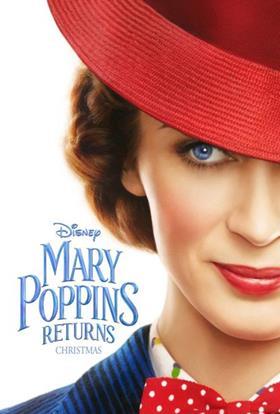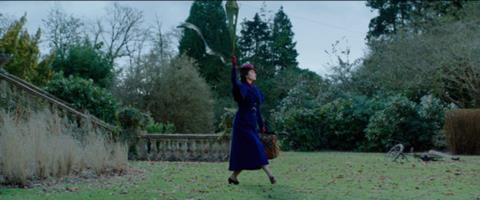Cinematographer Dion Beebe explains how he mixes digital production techniques with hand drawn animation and London location work to recreate Disney’s whimsical nanny.

The blending of animated penguins alongside actors Julie Andrews and Dick van Dyke in the 1964 classic Mary Poppins was as ground breaking technically as it was charming but could Disney’s sequel capture the same magic more than fifty years on?
Devising a style which paid homage to the original but also updated the story with a visually fresh take was the chief challenge facing director Rob Marshall and cinematographer Dion Beebe ACS ASC in preparation for Mary Poppins Returns.
“Going into the movie there was a lot of discussion about the long gap between the two films,” explains Beebe. “There is a lot of nostalgia for the original and love for the main character but we are also looking to reach a new audience. The audio-visual language of cinema has shifted a lot over the decades and an old-style movie wouldn’t necessarily appeal to today’s kids.”
“The funny thing was that in tests when we pushed the visuals too much in a stylistic way to try and modernise the look, it didn’t resonate”
This is Marshall and Beebe’s fifth feature collaboration and their fourth musical project following Chicago (2002), Nine (2009) and Into the Woods (2014). Beebe was Oscar nominated for Chicago and won for Memoirs of a Geisha in 2005, directed by Marshall.
“The funny thing was that in tests when we pushed the visuals too much in a stylistic way to try and modernise the look, it didn’t resonate,” says Beebe. “It didn’t feel true to the character and period somehow.”

The new film takes place 25 years after the original in the 1930s and finds the Banks family, which includes a grown-up Jane and Michael (Emily Mortimer and Ben Whishaw, respectively) as well as a new generation of children, struggling to cope with the loss of their mother. Whereas the original was filmed in gloriously eye-popping Technicolor, the sequel has a more nuanced palette.
“We enter the world of the film after the big crash of 1929, it’s Depression era London and the story revolves around their house being repossessed,” he explains. “The bold primary colours have faded a little to a cooler shade. But on Mary’s arrival things change. [Emily Blunt]’s Poppins introduces vivid colour into the picture as the kids start out on a fantastical journey of the imagination.”
Beebe shot multi-cam with two ARRI Alexa XTs and an Alexa Mini paired with Panavision G Series anamorphic primes as a nod towards the original.
“The optics lent the film a certain nostalgic look,” he says. He deployed ARRI’s Skypanel LEDs rather than hefty theatrical lights as the best way to control lighting cues and mood changes on location and in studio.

“Digital is a fantastic capture medium because it gives you an ability to explore looks in post but just because of all those choices it’s even more critical for me to find the look of a movie in pre-production,” he says.
“Testing is really key. I want to create the look in test to use on set while shooting.
This is important for production design in terms of how it affects the colour of walls, or for costume design in their choice of texture and fabric. Everyone can respond to the look of a film if they get a chance to see those tests in pre-production.”
The heart of the film is the songs, several of which pay homage to the original. For a reworking of the ‘Jolly Holiday’ song and penguin scene Marshall lured a number of Walt Disney animators out of retirement to create a number which mixed old style hand-drawn animations with live action.
“You’d be on set in discussions about the scene and one of the animators would grab a pen and paper and sketch a character,” explains Beebe.
- Read more Interview Maxine Gervais, Colourist
“Then you’d use this to visualise the sequence understanding, for example, that an animated character is only 2 ft tall so you have to ask the actors to relate to that. Rob began the sequence by choreographing the actors and in production we filmed them against green screen. [Editor] Wyatt Smith fine-tuned the footage and then the animators took that and we worked in their designs.
The whole scene was an elaborate visual storyboard in which rehearsals, recorded songs, editing and animation was iterated again and again.”
“I film the rehearsals and then talk with Rob about camera placement and specific shots”
Another scene has actors travelling in a hand-drawn animated carriage. “We rigged a mechanical device that our actors could sit on which would provide various physical motions and shot that against green screen.”
A set-piece action sequence around Big Ben and through central London was story boarded to gauge how much of the set would be physical, how much a VFX extension.
For the song ‘Stuff and Nonsense’, in which the characters swim underwater and is rendered in a totally CG environment, the scene was pre-visualised almost to the frame.

The more traditional song and dance numbers were evolved during rehearsals by Marshall and his cinematographer.
“I film the rehearsals and then talk with Rob about camera placement and specific shots,” says Beebe. “We’ve worked this way on musicals since Chicago.”
The set for Cherry Tree Lane was built on stage H, the largest soundstage at Shepperton along with sections of Big Ben, created by production designer John Myhre. A number of actual London street locations including around Bank and Threadneedle Street were also incorporated and used for scene transitions and the opening number ‘Underneath The Lovely London Sky’.
“Rob’s mantra when it comes to the musical genre is that you have to earn the song. You can’t just break into song. It’s got to flow out of the emotional content of the movie so it becomes part of the storytelling not just a musical interlude. The trick is to find ways of making the transitions into musical numbers so that it doesn’t feel forced.”
The most challenging sequence in this regard was for the song ‘Trip A Little Light Fantastic’, the sequel’s version of ‘Step In Time,’ the chimney sweep song from the original.
“The kids are walking the streets of central London and get lost in fog before finding Jack, the lamp lighter (Lin-Manuel Miranda), whose job it is to light the street’s gas lamps,” Beebe explains. “We begin this slow transition into what will become the film’s biggest dance number involving 40-50 dancers by devising ways in which he would turn on the lights by seemingly pointing at one lamp then another. So, we start from a real street location and as the scene builds we blend into the stage shoot and into a more fantastical landscape.”
Marshall’s affinity with the musical stems from his own background as a Broadway dancer and stage producer.
“He understands how to represent a show, says Beebe who says the director pays great attention to cast rehearsals of scene and song commencing six weeks before principal photography. “He understands how to frame a scene from his background in visual theatre. Movement is crucial in terms of both the actors and the camera.
“Ultimately, filmmaking is about choreography. When I move a camera or when he directs an action or for the actors everything is a bit of a dance.”
























No comments yet